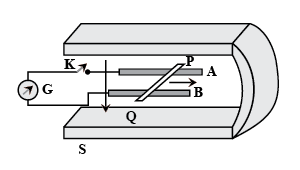Solving time: 6 mins
Figure 6.20 shows a metal rod PQ resting on the smooth rails AB and positioned between the poles of a permanent magnet. The rails, the rod, and the magnetic field are in three mutual perpendicular directions. A galvanometer G connects the rails through a switch K. Length of the rod = 15 cm, B = 0.50 T, resistance of the closed loop containing the rod = 9.0 mΩ. Assume the field to be uniform.
(a) Suppose K is open and the rod is moved with a speed of in the direction shown. Give the polarity and magnitude of the induced emf.
(b) Is there an excess charge built up at the ends of the rods when
K is open? What if K is closed?
(c) With K open and the rod moving uniformly, there is no net
force on the electrons in the rod PQ even though they do experience magnetic force due to the motion of the rod. Explain.
(d) What is the retarding force on the rod when K is closed?
(e) How much power is required (by an external agent) to keep
the rod moving at the same speed ( ) when K is closed?
How much power is required when K is open?
(f ) How much power is dissipated as heat in the closed circuit?
What is the source of this power?
(g) What is the induced emf in the moving rod if the magnetic field
is parallel to the rails instead of being perpendicular?

 Text solution
Text solution Verified
Verified
(b)
Yes; when key K is closed, excess charge is maintained by the continuous flow of current.
When key K is open, there is excess charge built up at both ends of the rods.
When key K is closed, excess charge is maintained by the continuous flow of current.
(c)
Magnetic force is cancelled by the electric force set-up due to the excess charge of opposite nature at both ends of the rod.
(d)
Retarding force exerted on the rod,
so,
(e)
Retarding force,
where,
so,
Also, Power
(f)
Power dissipated =
The source of this power external agent.
(g)
Zero. As, in this case, no emf is induced in the coil because the motion of the rod does not cut across the field lines.





Practice more questions from Physics Part-I (NCERT)
(a) Suppose K is open and the rod is moved with a speed of in the direction shown. Give the polarity and magnitude of the induced emf.
(b) Is there an excess charge built up at the ends of the rods when
K is open? What if K is closed?
(c) With K open and the rod moving uniformly, there is no net
force on the electrons in the rod PQ even though they do experience magnetic force due to the motion of the rod. Explain.
(d) What is the retarding force on the rod when K is closed?
(e) How much power is required (by an external agent) to keep
the rod moving at the same speed ( ) when K is closed?
How much power is required when K is open?
(f ) How much power is dissipated as heat in the closed circuit?
What is the source of this power?
(g) What is the induced emf in the moving rod if the magnetic field
is parallel to the rails instead of being perpendicular?
Practice questions from Physics Part-I (NCERT)
Views: 6,310
Views: 6,175
Views: 5,926
Views: 6,505
Practice more questions from Electromagnetic Induction
Views: 5,202
Views: 6,073
(a)
(b)
(c)
(d)
Practice questions on similar concepts asked by Filo students
Views: 5,381
Views: 5,428
Views: 5,690
Views: 5,365


Stuck on the question or explanation?
Connect with our Physics tutors online and get step by step solution of this question.
| Question Text | Figure 6.20 shows a metal rod PQ resting on the smooth rails AB and positioned between the poles of a permanent magnet. The rails, the rod, and the magnetic field are in three mutual perpendicular directions. A galvanometer G connects the rails through a switch K. Length of the rod = 15 cm, B = 0.50 T, resistance of the closed loop containing the rod = 9.0 mΩ. Assume the field to be uniform. (a) Suppose K is open and the rod is moved with a speed of in the direction shown. Give the polarity and magnitude of the induced emf. (b) Is there an excess charge built up at the ends of the rods when K is open? What if K is closed? (c) With K open and the rod moving uniformly, there is no net force on the electrons in the rod PQ even though they do experience magnetic force due to the motion of the rod. Explain. (d) What is the retarding force on the rod when K is closed? (e) How much power is required (by an external agent) to keep the rod moving at the same speed ( ) when K is closed? How much power is required when K is open? (f ) How much power is dissipated as heat in the closed circuit? What is the source of this power? (g) What is the induced emf in the moving rod if the magnetic field is parallel to the rails instead of being perpendicular? |
| Topic | Electromagnetic Induction |
| Subject | Physics |
| Class | Class 12 |
| Answer Type | Text solution:1 |
| Upvotes | 88 |



